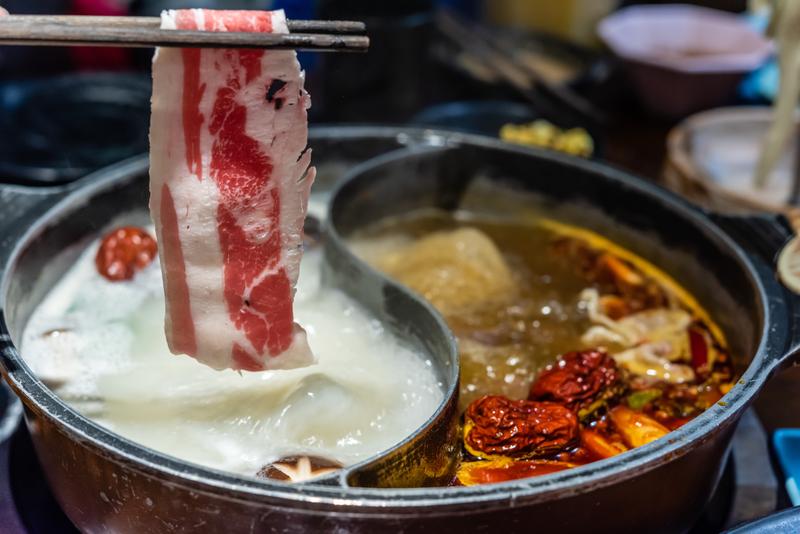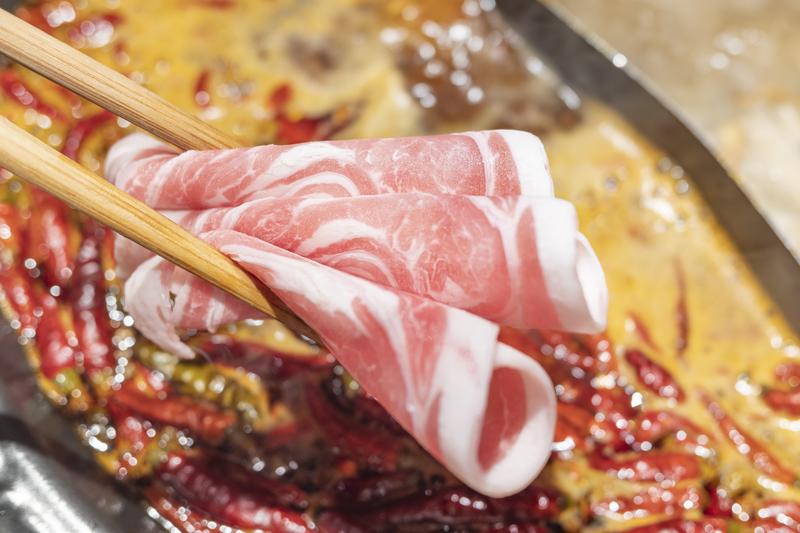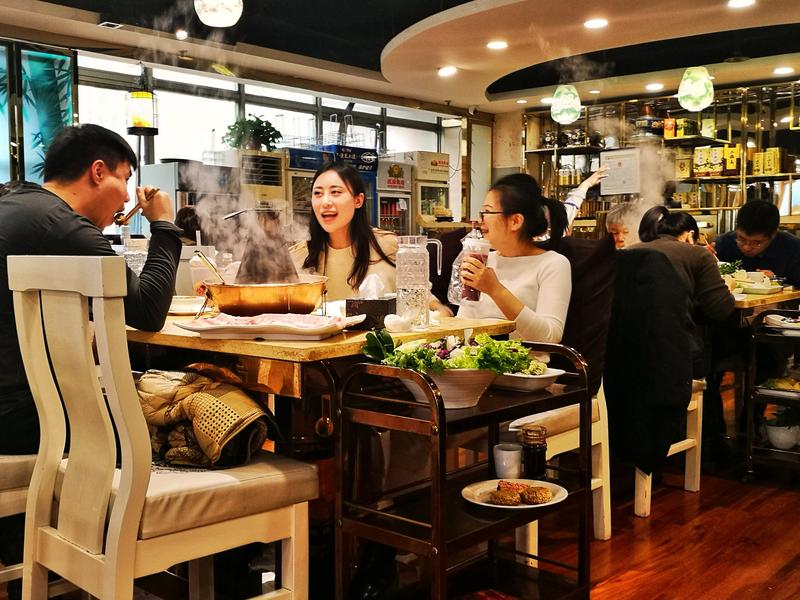As the days grow colder, follow the herd to the nearest mutton hotpot restaurant and find a cozy capital welcome, Yang Feiyue reports.
 Sitting around a steamy hotpot, with mutton as an indispensable ingredient, especially in chilly autumn and cold winter, has been a favorite of many Chinese people. (PHOTO PROVIDED TO CHINA DAILY)
Sitting around a steamy hotpot, with mutton as an indispensable ingredient, especially in chilly autumn and cold winter, has been a favorite of many Chinese people. (PHOTO PROVIDED TO CHINA DAILY)
As Chinese traditions go, few things are better than sitting around a steamy hotpot as autumn drapes a chilly cloak over North China.
Archaeological studies support the claim that Kublai Khan, the founder of the Yuan Dynasty (1271-1368), invented mutton hotpot.
The nomads relied on mutton during warfare, but in the frenzy of battle, Kublai Khan's subordinates had to make do with just dipping the mutton in boiling water to cook it for him.
I strayed for a short period in the past, creating many new ways to prepare and eat mutton, some of which I even had patented. But it didn’t go well
Cai Shihong, owner of Uncle Yang’s Mutton Hotpot (Yangdaye) restaurant in Beijing
For a long time, only Beijing's privileged, such as the aristocracy, could get their hands on mutton hotpot. It was very popular among the royal families of the Qing Dynasty (1644-1911). From the imperial food archives, Emperor Qianlong (1711-99) was a true hotpot lover, indulging himself with the bubbling dish more than 200 times in 1789.
Among the smorgasbord of vegetables and meat spread out on the dinner table, mutton has been put in the front and center.
The public believes mutton has the therapeutic effect of warming the body, which makes it an ideal food for the colder months. Moreover, sheep are generally fattened up after a summer of voracious eating, making them ideal for seeing meat lovers through the winter.
Many folk customs favor mutton over beef in part because cattle were once considered more important as a means of production.
Currently, the capital city is home to more than 2,000 mutton hotpot restaurants, according to restaurant- and cafe-rating platform, Dazhong Dianping, with a dozen well-known brands laying down roots, such as Jubaoyuan, Manfulou and Donglaishun.
Traditional Beijing instant boiled mutton is known for its simplicity, to the point that many southerners would think of it bordering on tedium. It has no saliva-inducing hotpot soup but plain water infused with some scallion and ginger slices. In some more luxurious cases, Chinese desert thorn, dried mushrooms and shrimps are added.
Since 1996, Cai Shihong has stuck to the old-fashioned way at his Uncle Yang's Mutton Hotpot (Yangdaye) restaurant in Beijing.
His business was small at first but was soon overwhelmed by legions of hungry customers.
From just six tables, Cai's mutton hotpot business has grown to six spacious venues in Beijing, Shanghai, Hubei province's Wuhan and Zhejiang province's Hangzhou.
 Sitting around a steamy hotpot, with mutton as an indispensable ingredient, especially in chilly autumn and cold winter, has been a favorite of many Chinese people. (PHOTO PROVIDED TO CHINA DAILY)
Sitting around a steamy hotpot, with mutton as an indispensable ingredient, especially in chilly autumn and cold winter, has been a favorite of many Chinese people. (PHOTO PROVIDED TO CHINA DAILY)
Outside business investors came knocking, offering franchise opportunities, but Cai refused most of them to ensure the quality of his product.
"I strayed for a short period in the past, creating many new ways to prepare and eat mutton, some of which I even had patented," says the 64-year-old Beijinger.
"But it didn't go well," Cai admits, adding that the key to his success is keeping everything traditional.
The quality of the mutton plays a significant role in the hotpot experience, and quality control should be in place from the very start.
The meat tastes the best when the sheep is about 1 to 2 years old, Cai says.
"Sheep growing up completely in the wilderness have too much muscle and too little fat, and are therefore hard to chew, while those who spend all their time in a pen will carry an odor that needs to be covered with spices."
The best meat comes from sheep reared in a combination of the two environments, so the fat and muscle are at an optimal balance for the taste buds, he adds.
Today, many mutton hotpot restaurants divide the meat into a dozen categories based on which part of a sheep it is cut from.
The rear legs are full of muscle, quite chewy and are especially preferred by diners hailing from the Inner Mongolia autonomous region.
Modern diners are warming to cuts less commonly served for hotpot, such as the shanks and chops.
"Magic happens when those parts are frozen and then sliced for hotpot," Cai says.
The shanks are full of tendons and taste fresh and light, while the chops look fatty but taste glutinous instead of greasy.
"They are popular among our female customers," he says.
Good knife and butchery skills also count for a lot.
An experienced chef can slice the meat so thin that people can read the words of a book through the meat.
Although the advent of mutton slicers has relieved chefs of manual butchery to a large degree, many restaurants have retained the tradition of hand-cutting meat.
"The skill of slicing the meat is actually a culture in and of itself,"Cai says.
 Diners have mutton hotpot in Donglaishun, a well-known restaurant of the kind in Beijing. (MA HUAIGANG / FOR CHINA DAILY)
Diners have mutton hotpot in Donglaishun, a well-known restaurant of the kind in Beijing. (MA HUAIGANG / FOR CHINA DAILY)
At Donglaishun in Beijing, Chen Lixin has become the fourth-generation inheritor of the restaurant brand's mutton slicing technique that was named a national intangible cultural heritage in 2008.
The sliced rear leg should contain relatively more fat and less lean meat, so the dipped meat can be consistent in thickness.
He says that even his master teacher could only slice 120 plates a day.
Mutton slicing has even become a performance art at the restaurants these days.
Frozen tofu, Chinese cabbage, vermicelli made from bean starch and baked pancakes are equally indispensable ingredients in authentic old-fashioned mutton hotpot.
When the water boils, a dish of fatty slices from the tail is poured in to grease the pot, and then the mutton slices can be added. After the meat, it's time for frozen tofu, which will absorb the mutton soup and create an explosion of flavor on the palate. Then, cabbage leaves can be baptized in the brine to balance the taste and nutrition, easing the cloying of the rich, meaty flavors and making room for the last serving of the baked sesame pancakes.
The copper pot and ingredients, including sesame sauce, chili oil, pickled leek flowers and vinegar, also have to be present to complete the ritual.
Certain old ways, though, have been adapted to modern tastes and requirements.
At Manhengji mutton hotpot restaurant in Beijing, boss Man Jun has installed ventilators on each table to remove the smoke from the burning charcoals.
He believes it makes for a better guest experience.
Cai replaced the charcoal grill with an electric hot plate following customer requests for cleaner air.
He also invented a way of serving the sliced meat on a meter-long wooden board, which creates a visual impact and was quickly adopted nationwide.
In the old days, such restaurants only started serving mutton hotpot from Mid-Autumn Festival (the 15th day of the eighth lunar month). Business often waned after Spring Festival. And some staffers would have to find a new job after Dragon Boat Festival (the fifth day of the fifth lunar month), when business came to a halt. Today, however, mutton hotpot has become a perennial favorite to China's gourmands.
The technology development in mutton production has allowed for year-round supplies of fresh meat.
"We have guests waiting in a long line during winter, and while summer sees such extreme demand drop off, our tables are still often fully booked," Cai says.
Contact the writer at yangfeiyue@chinadaily.com.cn


